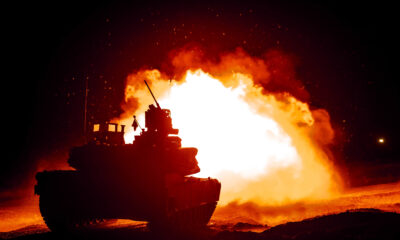Executive
No Time To Waste: Updating and Upscaling the American Defense Industrial Base Has To Happen Now
The American defense industrial base shrunk critically after the Cold War ended. America now needs to rebuild it.

The end of the Cold War in the early 1990s ushered in an unprecedented era of relative stability in the world. But this newfound peace among nation states also brought an unforeseen existential threat: at the direction of the Department of Defense, the defense industrial base shrunk, and with it, America’s heretofore formidable industrial capacity.
Unfortunately, the world has entered a new, scarier reality and today, we face a landscape more dangerous and chaotic than at any time in recent memory. The U.S. and its allies are balancing a number of equally-menacing fires across the globe: barbaric terrorist attacks in Israel and a war with Hamas that threatens to destabilize the entire Middle East; an Iranian regime funding proxy terrorist groups to do its dirty work; a war in Ukraine and an emboldened dictator in Vladimir Putin; ballistic missiles being developed by North Korea in order to reach our shores in the Pacific; and sadly, so much more.
Particularly concerning to those of us who have been in national security for decades is the threat from China that has spurred an arms race to develop, innovate, and manufacture new defense tools and technologies at a back-breaking pace. Unfortunately, the U.S.’s ‘arsenal of democracy’ has greatly eroded.
An example of this problem can be seen when looking at the size and effectiveness of our navy. China is intent on building a large strategic nuclear force and has already built the world’s largest navy. Whereas we once had sixteen shipyards (as the Chinese do now), we now have nine—only five of which can perform original design and construction of naval ships. The USG cannot stand idly by; it must ensure, at a minimum, that our ships are technologically superior in order to make up for the fact that we no longer have the numbers on our side.
While the strategic picture has changed greatly over the past three decades, the harsh reality is that our current defense industrial base is not structured nor prepared to give us the advantage we require. Of the fifteen ammunition plants which operated during the peak of the Cold War, only five remain—all in need of updating but still working hard to meet the unexpected needs in Ukraine and Israel. And while fourteen companies once competed to design, manufacture, and sustain high-performance military aircraft, just three remain today.
The size of our defense production base does not meet the demands of our new strategic circumstances. It will take bold, coordinated action from Congress, the administration, and the private sector to dig our way out of this current situation.
The path forward needs to expand cooperation between the government and its major providers by identifying emerging needs sooner and taking steps to encourage shorter timelines between the development and fielding of new capabilities. Importantly, barriers to entry need to be lowered for smaller, non-traditional firms offering new technologies with defense applications. And Congress must provide predictable, timely funding.
We also must leverage the capabilities of our allies and partners around the world, many of whom share our concerns about the new security challenges. Some of that effort is already evident with agreements such as the one recently signed by Australia, the United Kingdom, and the United States (AUKUS). Similar arrangements are being negotiated with other trusted U.S. partners and allies.
The Department of Defense is painfully aware of this significant issue and has developed a strategic vision to guide, expand, and modernize the defense industry. Under the leadership of Deputy Secretary of Defense Kath Hicks, Under Secretary Bill LaPlante, and Assistant Secretary Laura Taylor-Kale, a new National Defense Industrial Strategy (NDIS) has been developed to incentivize new capital investment and expand and sustain new capacity.
The war in Ukraine has highlighted the deficiencies of our defense industrial base, especially when it comes to critical aspects of warfare. Make no mistake, the U.S. is struggling to keep up with the demand for our own warfighting plans, let alone provide military aid to our allies in Ukraine, Taiwan, and Israel. The NDIS is a solid and long-overdue start, but it is a roadmap: a declaration of a problem recognized and identified and needing near-term attention.
The onus is now on our nation’s leaders to approve plans, pass budgets, and work across the aisle to deal with the problems of tomorrow, not just those of today. Implementing the NDIS will be expensive but the cost of inaction for the American people and our allies around the world will be incalculably higher.
This article was originally published by RealClearDefense and made available via RealClearWire.
Major General Arnold Punaro (U.S. Marine Corps, ret.) served as the Director of the Marine Corps Reserve, Deputy Commanding General, Marine Corps Combat Development Command (Mobilization), and for three years as the Commanding General of the 4th Marine Division. He recently retired following 12 years of service as the Chairman of the Department of Defense’s Reserve Forces Policy Board and was also a former Staff Director of the Senate Armed Services Committee and former Chairman of the National Defense Industrial Association.
-

 Education3 days ago
Education3 days ago‘Grading for Equity’: Promoting Students by Banning Grades of Zero and Leaving No Class Cut-Ups Behind
-

 Family3 days ago
Family3 days agoIdaho defends against abortion mandate
-

 Civilization4 days ago
Civilization4 days agoNewsom plays silly abortion politics
-

 Constitution2 days ago
Constitution2 days agoPresidential immunity question goes to SCOTUS
-

 Civilization4 days ago
Civilization4 days agoWaste of the Day: China Still Owes Over $1 Trillion to American Bondholders
-

 Education15 hours ago
Education15 hours agoCHAPTER 11: Critical Race Theory: A Species of the Ideological Thought Genus Marxism
Space Is No Longer the Final Frontier—Reality Is [forthcoming release May 2024] -

 Civilization4 days ago
Civilization4 days agoCurrent Conflicts Demonstrate Need for More and Better Tanks In Eastern Europe
-

 Civilization2 days ago
Civilization2 days agoMarine Corps Force Design: In Defense of Chowder II








